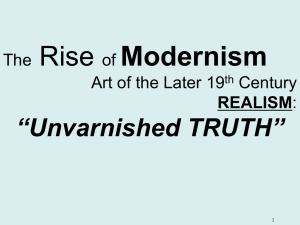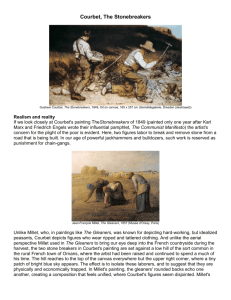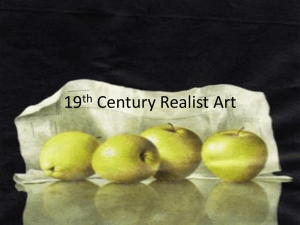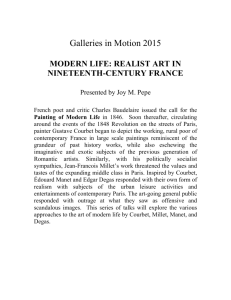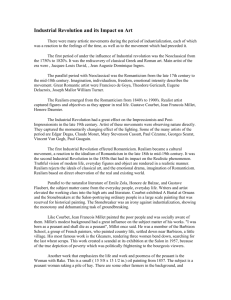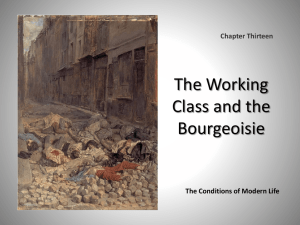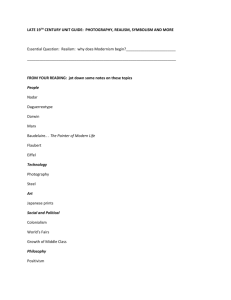Realism
advertisement
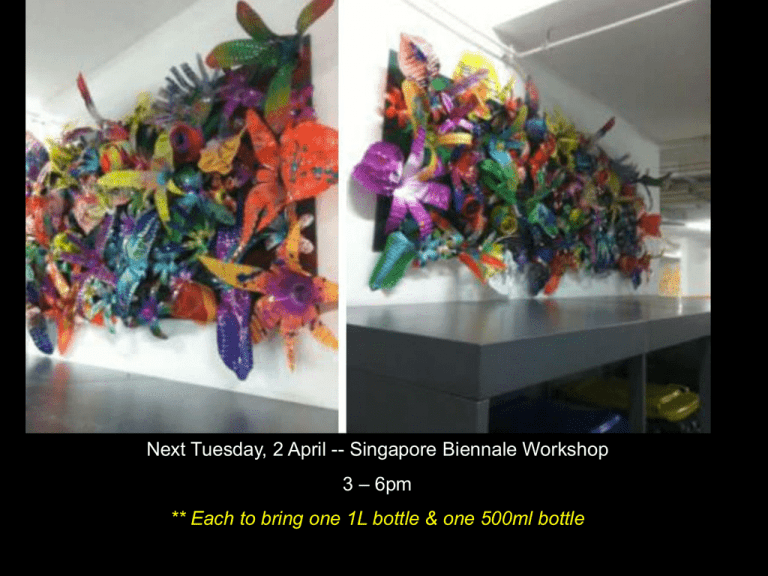
Next Tuesday, 2 April -- Singapore Biennale Workshop 3 – 6pm ** Each to bring one 1L bottle & one 500ml bottle 2nd Half of the 19th Century – REALISM REALISM • Unidealized and objective representation – Realist artists rebelled against the idealized subjects of mythical and historical painting and turned to contemporary ones Gustave Courbet (1819 – 1877) “… painting is essentially a concrete art and must be applied to real and existing things” Gustave Courbet (1819 – 1877) • French painter • Father of Realism • Rejected idealization -- Believed that things should be painted as they exist • Set out to paint only the life of his own times in the costumes of the day • Key subject matter – Peasants & workers Gustave Courbet (1819 – 1877) A Burial at Ornans 1849-50 Oil on canvas 315 x 668 cm Jean-Francois Millet (1814 – 1875) • French painter inspired by the social issues raised by the 1848 Revolution • Set out to glorify the humble country folk of France by endowing them with heroic form adapted from the art of the past • Key subject matter: Peasants & workers Francois Millet (1814 – 1875) The Gleaners 1857 Oil on canvas Honore Daumier (1808 – 1879) • French caricaturist & painter • Concerned with the effects of urban industrial civilization • Key subject matter: Political and social unrest and the sufferings of the working class • Style: Involved building up broad forms from several washes and with strong black outlines in an almost sculptural manner Honore Daumier (1808 – 1879) The Third-Class Carriage 1863-65 Oil on canvas Reporting on the Realists • In your groups, read the brief introduction to the work , take a close look at the painting and discuss. • Then, individually imagine that you are a journalist reporting on the artist’s work, how will your article look like. – Plan for the headlines to your article and a short 2 paragraph report. Gustave Courbet (1819 – 1877) A Burial at Ornans 1849-50 Oil on canvas Courbet depicts a funeral in a bleak, provincial landscape, attended by commoners of no importance. The faces are faithful portraits of the poor, each with their own expression. Dressed in rusty black, they cluster around the excavation, while the clergymen reads the Office of the Dead. Here, Courbet monumentalizes a theme that was of little significance instead of anything heroic or sublime. What Courbet now finds interesting is in his own environment; it is people – not as superhuman or subhuman actors on a grand stage, but as themselves, moved by the ordinary rhythms of modern life. Gustave Courbet (1819 – 1877) Stonebreakers 1849-50 Oil on canvas Gustave Courbet (1819 – 1877) Stonebreakers 1849-50 Oil on canvas Inspired by the ‘complete expression of human misery’ in an encounter with an old road worker in tattered clothes and his young assistant, Courbet asked them to pose for him in his studio. Painting the road workers life size on a large canvas, Courbet showed them absorbed in their task, faceless and anonymous, dulled by the relentless, numbingly repetitive task of breaking stone to build a road. Here, Courbet set every detail of his lowborn workers’ wretched state before the viewer. Gustave Courbet (1819 – 1877) The Desperate Man 1844-5 oil on canvas Courbet -- Style • Depicted ordinary scenes from contemporary life on an epic size normally reserved for history painting • Used the palette knife as painting tool to apply rich, thick paint (impasto) onto the canvas Francois Millet (1814 – 1875) The Gleaners 1857 Oil on canvas Here, Millet posed three peasants as monumental figures against the field and sky. They are bent over and going about their duties in a diligent manner. The quiet atmosphere coupled with the attention to detail contributed to the dignity Millet gave to the simplest rural task. The figures are invested with a solemn grandeur and the soft, warm tones conjure a sense of sentimentality. Francois Millet (1814 – 1875) The Sower 1850 Oil on canvas Francois Millet (1814 – 1875) The Sower 1850 Oil on canvas Powerful and monumental, Millet’s sower strides across a newly plowed field with energy and resolution, scattering the seed for a new crop; he serves as an emblem of regeneration and of the elemental relationship between man and nature. Crude in appearance, the work provoked commentary not only on its subject matter but also on its style and technique. A critic noted that Millet “trowels on top of his dishcloth of a canvas, without oil or turpentine, vast masonries of coloured paint so dry that no varnish could quench its thirst” Honore Daumier (1808 – 1879) The Uprising c. 1860 Oil on canvas Honore Daumier (1808 – 1879) The Third-Class Carriage 1863-65 Oil on canvas This unfinished work gives us a glimpse into the railway compartment of the 1860s, in which sit the poor, who can afford only third-class tickets. The commuters are presented in an unposed manner, just as how they appear to Daumier. The faces of the commuters appear tired, impersonal and blank. Review of Collage Portraits Collage Portrait • Using the documentation that you have collected, arrange and create a collage portrait of yourself that shares with us your identity, personality, your fears and dreams. • As you explore the many possibilities in layout, document using photography the different arrangements that you have tried before deciding on the final composition. Portraits using contours • Pair up with a friend • Take a close look at the face & features of your friend. Using a continuous line, attempt to represent your observations on your piece of paper. – Your only constraint is that you are not allowed to look at your drawing whilst drawing. Wire Portraits • Using your contour portrait as a guide, create a wire portrait of yourself, paying attention to how the lines can be used to express your personality • If you choose to, you can incorporate the use of colourful yarn into your wire portrait for more expressive possibilities.
